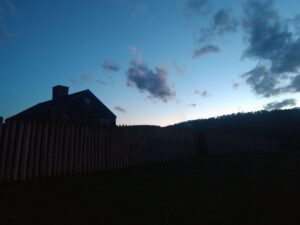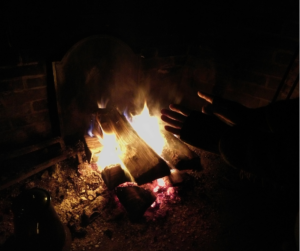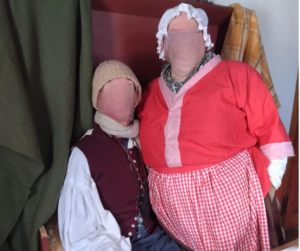
Now, I realize not everyone is able to have a house in the boonies with a wood stove. I am smug enough to think that anyone who considers the government to be in decline, and the cities to be largely unlivable, OUGHT to live in the boonies, regardless of their other foibles. What do I mean by that? Well, let me explain.
Years ago, I lived in the big suburbs of a big city. I was okay with it, though I wouldn’t go so far as to say I liked it. Then I was given a nudge by the gods… I lost my job and my home in one fell swoop, and was forced to make a jump. In doing so, I miraculously landed not only on my feet, but in a much better situation overall. I wish I’d made that jump years earlier. Regardless, I found myself in a wonderful situation, living a life I had previously only dreamed of.
These days, I live in a sprawling home on the suburban/rural edge of a very small town. We only have an acre or so of land, but we back onto a multi-acre piece that is private and beautiful, and more importantly is not posted. This means we can hunt there, we can camp, we can play, and our kids can run amok. It’s been wonderful. I have gardens, sometimes more fruitful than other times. I have firewood galore, just from fallen trees out back (which we have permission to harvest). There’s potable water close by, and I have the means to cart it and filter it to make it safe (if it was unsafe). In some years, there’s a stream out back, if you know where to look, which isn’t huge but is big enough and is ground water and therefore pretty likely to be clean.
Our power went out for a day. Previously we’ve lost power for longer than that, but this time it was just a day. We knew it was likely to happen, though it hit us much earlier than I’d thought. Apparently a local transformer blew up and started a two alarm fire. Whee… exciting times. That’s aside from the usual branches taking down lines. When we get icy rain like we did, it’s just one of those things that happens. It’s the price of living in a place that has shade and privacy and lush, green beauty all around.
I’ve heard people say that the trees ought to be taken down. Why? To protect the power lines, apparently. While I sympathize with power lines being downed, that’s not a reason to be defacing my property. Your (the faceless mass of “your” here) desire to force me to address things that may happen will not cause me to do so. As an example, neighbors noted that one of our trees is dead. It’s standing firewood right now. Unfortunately, it’s not in a place that’s easy to bring it down, so we’ve left it alone. It’s not rotting at present, and it’s not causing any issues. It doesn’t sway nearly as much as the other trees. And unlike our neighbor’s trees, it hasn’t fallen and caused damage to a house. Regardless, we have insurance to cover just such emergencies. It’s our tree, and our choice. Our neighbors can “want” us to take it down all they like, just like the “want” us to not have firearms, or enjoy our firepit, or raise chickens, or any of the other fun things we do. They can “want” as much as they like. What they can’t do is compel.
When we get to the point of compelling people to do things, I have a problem. “Public safety” is the first thing that gun grabbers usually mention. It would be so much SAFER if the guns were just not in public possession. Leaving aside the fact that I disagree with that to the extreme, the thing is, I don’t care. My concern is for MY family. My firearms protect MY people. Going a bit further, my woodstove heats MY family, my food feeds us. Public safety only goes so far.
When I hear that I ought to have all my beautiful privacy trees cut down for “public safety,” I start squinting my eyes and looking sideways at people. No thank you. I said NO THANK YOU sir. Giving up my trees is one step toward giving up my other freedoms.
All that leads me to what I asked in the title: Whose job is it, anyhow?
Whose job is it to protect my family? Ours. Whose job is it to feed my family? Ours. Whose job is it to keep my family sheltered and warm? Ours. It is not the government’s job. The moment you give ground in that direction, you may as well slide all the way down the leftist hill.
When the power went out, I wasn’t actually at home. When I did get home, the kids had the wood stove going, and had pulled out some oil lanterns and solar lights to see. Our battery back up packs had been located and put on the dining room table for anyone who needed them. We didn’t bother firing up the generator, because it’s cold outside. The food in our freezers was going to stay frozen without any issues (our freezers are actually outside), and the food in the fridge just got packed up and put into raccoon safe boxes on the porch, where it was cold enough to keep it as well as the fridge. People were reading books. I came in and sat and sewed for a while while we listened to a book on tape that I have downloaded for just such emergencies. Dinner was switched from an oven meal to a stove top meal, one that could be easily made with the gas stove (which runs without electricity). If I’d been home, I’d still have made the oven item; I have dutch ovens, and I know how to use them. Honestly, the kids do too, but they were being lazy, and that was fine.
That night, I cuddled up under warm blankets, in my bed. If it had been colder (it was really only a little below freezing), I might have gotten out the military sleep system, but I didn’t see the need. I also could have slept in the living room, where the wood stove was banked for the night, but again, it wasn’t that cold. I wore my night cap, and so even my head was warm.
Water was still running in one of our bathrooms, so we continued to use that. If it had stopped, we had bucket potties we could have pulled out to use. We had the means to heat water, both on the gas stove and on the wood stove, so we were able to wash. Camp showers are wonderful things.
So yeah… If you are in a city, there are lots of things you can do, even if you can’t have a fireplace or wood stove. If you need help learning how to prepare for such things, I’m more than happy to teach. In fact, I offered to do so for a local lady who spent 24 hours straight complaining about how horrid it was she had no electricity. I was a bit shocked, because it’s a friend who is normally fairly balanced and thoughtful… but she just lost it. She was whining about “losing all the food in her fridge,” when I privately contacted her and suggested that the gods had provided a giant outdoor fridge, just for her. I offered to help her learn how to deal with this stuff. Why? Because everyone should know how to go a few days or weeks without power. We get snow here, and other areas get hurricanes or tornadoes or tsunamis or earthquakes, or whatever it is that endangers your area. Learning to be self sufficient for the common emergencies of your place of living is not just important, it is your duty.
IMO of course.
Hagar,
who recently spent the night in an 18th century fort on an 11*F night, by choice
Like this:
Like Loading...






